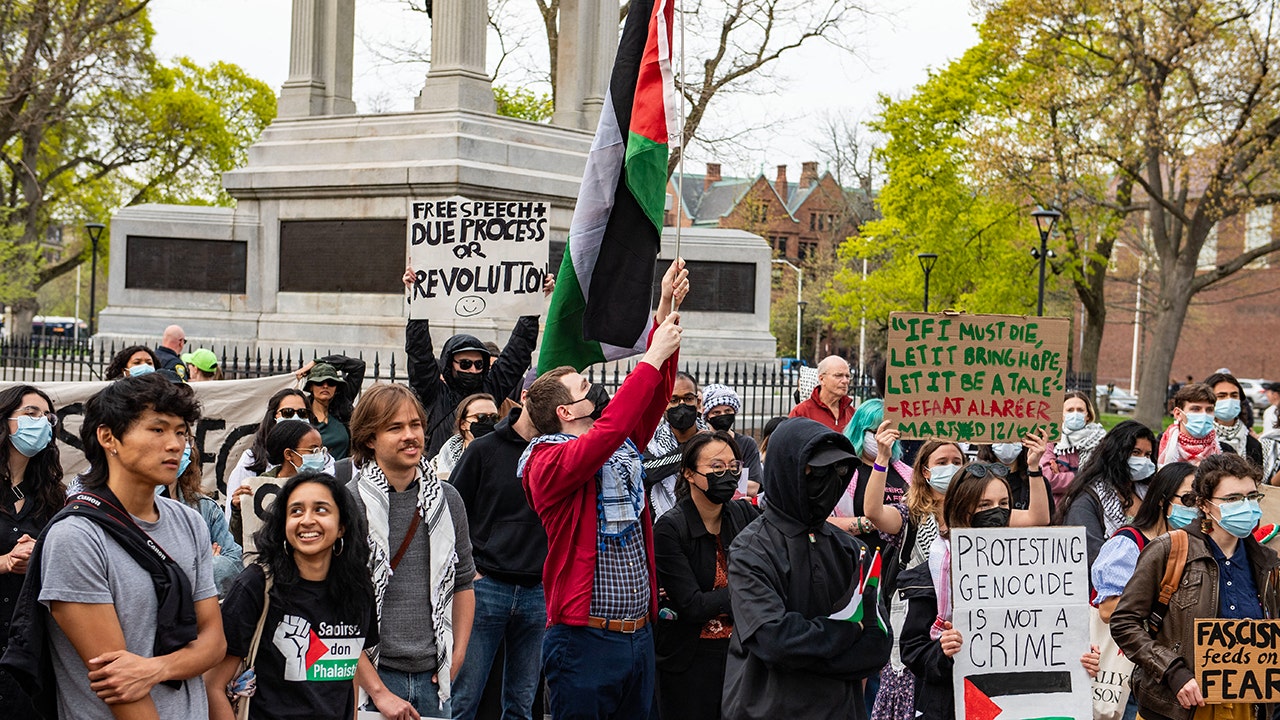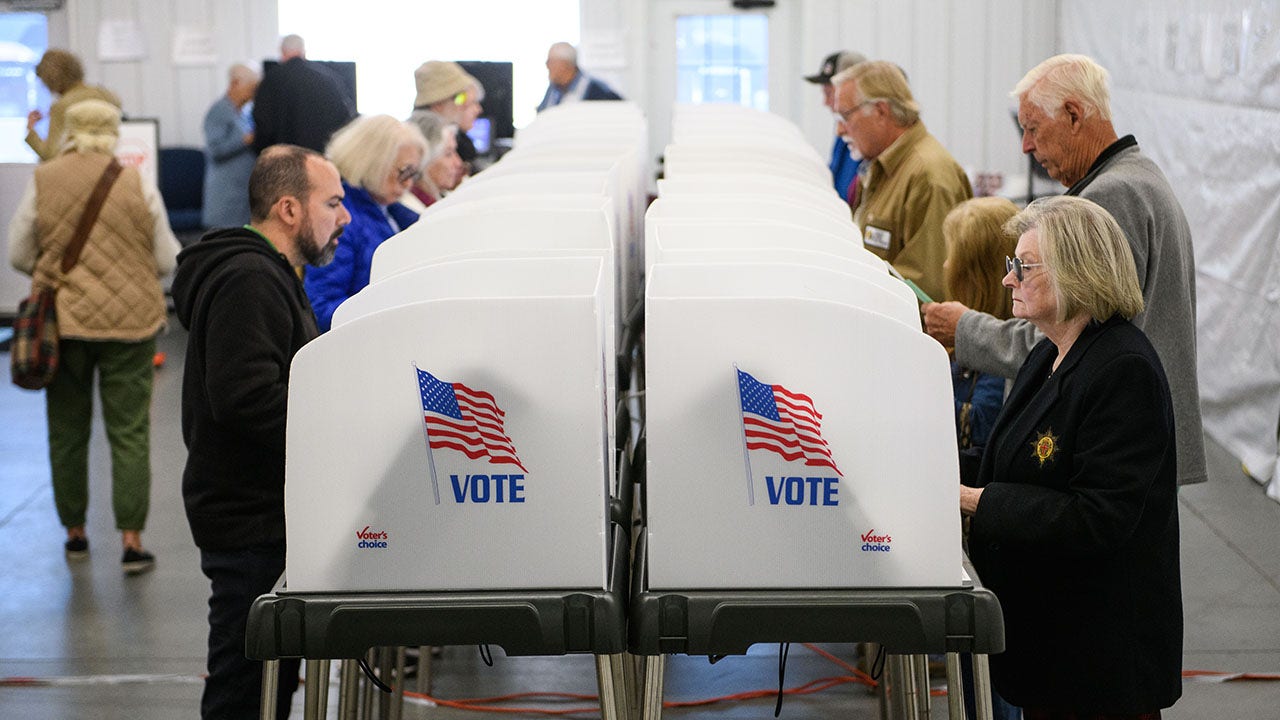New York
Gold Bullion and Halal Meat: Inside the Menendez Investigation

It was January 2018, and Senator Robert Menendez of New Jersey had just won a huge legal victory. His trial on federal bribery charges had ended in a hung jury, and the U.S. Justice Department had announced that it would not seek a new trial. He was free to walk with no criminal conviction, ready to take on another campaign for re-election.
Weeks later, he started dating Nadine Arslanian.
Ms. Arslanian, who would eventually marry Mr. Menendez, quickly introduced him to one of her longtime friends: Wael Hana, an Egyptian American businessman in New Jersey. The future Ms. Menendez was eager to connect her influential new boyfriend with Mr. Hana’s high-level connections in the Egyptian government.
What unfolded in the next four years is what prosecutors described on Friday as a sprawling corruption scheme that would ensnare the halal meat industry, American military aid to Egypt and the appointment of a top New Jersey law enforcement official. Prosecutors accused Mr. Menendez, 69, of abusing his power to influence arms sales to Egypt and to attempt to interfere with criminal investigations into Mr. Hana’s web of business associates.
An F.B.I. search last year of the couple’s New Jersey home revealed some of the fruits of their scheme, prosecutors said. Federal agents found more than $480,000 in cash stuffed throughout the house in envelopes and in the pockets of jackets that were embroidered with the senator’s name. Inside the home were more than $100,000 worth of gold bars, some of which had unique serial numbers that traced back to Mr. Hana. A shiny Mercedes-Benz convertible sat in the garage.
The 39-page indictment — which laid out in painstaking detail a series of deleted text messages, encrypted phone calls and shell company payments — painted a portrait of a couple motivated by relentless greed.
Ms. Menendez, 56, often pestered her associates for more bribe payments, prosecutors said, and did not hesitate to peacock her husband’s influence, once sending a news article to Mr. Hana about $2.5 billion of military sales to Egypt and writing, “Bob had to sign off on this.” The business associates around Mr. Hana seemed to find more and more ways to extract what they needed from Mr. Menendez, as long as they could deliver the cash.
The bribes even included two exercise machines and an air purifier that were delivered to the Menendez home, prosecutors said.
Mr. Menendez maintained his innocence on Friday, accusing the Manhattan federal prosecutors who brought the case of misrepresenting routine congressional work. Lawyers for Ms. Menendez and Mr. Hana, 40, also denied the charges.
When Ms. Menendez started dating Mr. Menendez in early 2018, she was unemployed. But her new relationship offered a solution.
Mr. Hana would agree to put Ms. Menendez on the payroll of his halal meat company if Mr. Menendez could promise to help facilitate more sales of military equipment to Egypt, prosecutors said.
At the time, the issue was a high priority for the Egyptian government because the U.S. State Department had been withholding some military aid until the country could show improvements on human rights. As the ranking member — and soon-to-be chairman — of the Senate Foreign Relations Committee, Mr. Menendez exerted significant influence over how much military aid the United States supplied to Egypt and other countries.
Mr. Menendez shared sensitive information from the State Department about the number and nationalities of people working at the U.S. embassy in Cairo with his girlfriend, who passed it to Mr. Hana, who forwarded it to an Egyptian government official, prosecutors said. Mr. Menendez also agreed to ghostwrite a letter from an Egyptian official who wished to urge the U.S. Senate for more military aid to Egypt.
In July 2018, after meetings between Mr. Menendez and Egyptian officials, he texted Ms. Menendez to tell Mr. Hana that he was going to sign off on a multimillion-dollar weapons sale to Egypt. Ms. Menendez forwarded the text to Mr. Hana, who sent it to two Egyptian officials, one of whom replied with a thumbs up emoji.
Mr. Hana and his business associate, Jose Uribe, then saw another opening to use Mr. Menendez, prosecutors said. They knew that Ms. Menendez had recently gotten into a car accident and needed a car, so they offered to buy the couple a new Mercedes-Benz C-300 convertible, worth more than $60,000.
In exchange, they asked Mr. Menendez to interfere in an ongoing prosecution and criminal investigation involving Mr. Uribe’s business associates. Mr. Uribe, 56, who worked in the trucking and insurance industries, had been previously convicted of fraud.
In early 2019, Mr. Menendez contacted a senior prosecutor at the New Jersey attorney general’s office who was supervising the cases and pressured him to resolve them favorably for the defendants, the indictment said. The prosecutor did not agree to intervene, but one of the cases ultimately resulted in a plea deal with no jail time. In the other, no charges were ever brought.
A few days after Mr. Menendez called the prosecutor, Ms. Menendez texted Mr. Hana: “All is GREAT! I’m so excited to get a car next week.”
She met Mr. Uribe in a parking lot of a restaurant, where he gave her about $15,000 in cash, and made the down payment on her new Mercedes the next day. “You are a miracle worker who makes dreams come true I will always remember that,” she texted Mr. Uribe.
But around this time, a problem arose. Mr. Hana’s halal meat company, IS EG Halal Certified Inc., had little to no revenue. Ms. Menendez, who prosecutors said had been given a “low-or-no-show job” there, started to complain to Mr. Hana’s business associates that she wasn’t getting paid. She texted Mr. Menendez about how upset she was about Mr. Hana’s broken promises.
A major break came in the spring of 2019. The Egyptian government gave Mr. Hana’s company a monopoly over certifying American food exports to Egypt as compliant with halal standards, in adherence with Islamic law. Mr. Hana’s company, despite its name, had no experience with halal certification.
A huge financial windfall was coming.
The day after an Egyptian official informed Mr. Hana that his company was most likely going to become the sole halal certifier for U.S. imports, Ms. Menendez texted the senator: “Seems like halal went through. It might be a fantastic 2019 all the way around.” The indictment did not say if Mr. Menendez used his position to influence Egypt’s decision.
Soon afterward, Ms. Menendez created a consulting company, Strategic International Business Consultants LLC, which prosecutors said was used to receive tens of thousands of dollars in bribe payments.
Mr. Hana’s monopoly, however, increased costs for some U.S. meat suppliers, which did not escape the notice of the U.S. Department of Agriculture. In the spring of 2019, U.S.D.A. officials asked Egypt to reconsider the monopoly rights for halal certification, which had previously been granted to a handful of companies.
At Mr. Hana’s request, Mr. Menendez called a high-level U.S.D.A. official and asked them to stop opposing the monopoly, prosecutors said. The official did not acquiesce to Mr. Menendez’s demands, but Mr. Hana still kept sole control over the Egyptian certification.
Two months later, prosecutors said, Mr. Hana used his halal company to pay about $23,000 to Ms. Menendez to help her stay current on her mortgage while she was in foreclosure proceedings.
Still, prosecutors suggested, Ms. Menendez felt she deserved more money for all the help that her boyfriend was giving Mr. Hana, especially after the senator had agreed to meet with some senior Egyptian officials. She texted Mr. Menendez: “I am soooooo upset.”
She wanted to complain to one of Mr. Hana’s business associates, but Mr. Menendez warned her: “No, you should not text or email.” She placed a call instead. The next day, Mr. Hana’s halal company wired $10,000 to her consulting firm.
As their scheme expanded, prosecutors said, they deleted more and more texts and emails.
A few months after the couple married in October 2020, Mr. Menendez met with Philip Sellinger, a potential candidate to be nominated for U.S. attorney in New Jersey, the top federal prosecutor in the state.
This time, the indictment said, Mr. Menendez was carrying out his end of another corrupt bargain. In the meeting, Mr. Menendez criticized the ongoing case against Fred Daibes, who was indicted in 2018 by federal prosecutors in New Jersey. He also happened to be a business associate of Mr. Hana and a longtime fund-raiser for Mr. Menendez.
When Mr. Sellinger said that he might have to recuse himself from the investigation anyway because of a prior conflict of interest, Mr. Menendez said he would not be recommending him for U.S. attorney, according to the indictment.
Ultimately, Mr. Menendez did recommend Mr. Sellinger for the nomination, believing that he could influence the investigation if Mr. Sellinger held that post, prosecutors said. The indictment did not say why Mr. Menendez believed that.
In early 2022, Mr. Menendez placed two phone calls to the federal prosecutor overseeing Mr. Daibes’s case. Minutes after the second call, Mr. Menendez called Mr. Daibes directly.
Two months later, Ms. Menendez ate lunch with Mr. Daibes and texted him afterward: “THANK YOU Fred,” with a slew of emojis. The next day, Ms. Menendez met with a jeweler who was friends with Mr. Daibes and sold the jeweler two gold bars that prosecutors believe were previously owned by Mr. Daibes, worth about $120,000 at the time.
The New Jersey U.S. attorney’s office did not bend to the pressure campaign, the indictment said. Mr. Daibes pleaded guilty in April 2022.
But the unraveling for the Menendez couple would soon begin.
In June 2022, federal agents raided their home. Some of the envelopes containing the wads of cash had the fingerprints and D.N.A. of Mr. Daibes and his driver — marked with Mr. Daibes’s return address, prosecutors said.
After the search, Mr. Uribe stopped making the monthly payments on the Mercedes convertible. Mr. Menendez wrote his wife a check for $23,000, part of which she gave to Mr. Uribe with the memo line: “personal loan.” The indictment did not make clear what the purpose of the payment was.
It was too late. On Friday, Mr. Menendez was indicted on three federal charges and temporarily stepped down from his chairmanship of the Senate Foreign Relations Committee. The indictment also charged his wife, Mr. Hana, Mr. Uribe and Mr. Daibes.
A lawyer for Mr. Daibes said he was confident his client would be exonerated of the charges. A lawyer for Mr. Uribe could not immediately be identified.
In response to growing calls for his resignation, Mr. Menendez issued a new statement late Friday.
“It is not lost on me how quickly some are rushing to judge a Latino and push him out of his seat,” he said. “I am not going anywhere.”
Tracey Tully contributed reporting.

New York
N.Y.C.’s Mayoral Candidates Spent Millions on TV Ads. What Are They Saying?

Estimated spending on
broadcast ads that have aired
$1.1 million
$4.3 million
The Democrats running for mayor in New York City and a super PAC supporting Andrew M. Cuomo are spending millions to reach potential voters, with much of the spending going toward commercials on broadcast television. A New York Times analysis of the broadcast ads that have aired so far, using data from AdImpact, explored the major themes highlighted by the candidates: crime and safety, President Trump, affordable housing and corruption.
Among the ads aired,
seven mention crime and safety
3 ads
Mr. Cuomo, the former governor, has been framing himself as a law-and-order candidate who will crack down on crime and improve public safety. Ads run by Fix the City, the super PAC backing Mr. Cuomo, have depicted New York as a city in chaos. One of its ads opens with images of police sirens, caution tape and subway riders fleeing a smoke-filled train.
“Crime is rampant,” says a voiceover in another pro-Cuomo ad, also paid for by Fix the City. That ad also references Mr. Cuomo’s “five-borough crime and affordability plan,” which would add “5,000 more cops” to the streets.
Other candidates took a subtler approach. Scott Stringer, a former city comptroller, said in his only broadcast ad to air so far that he would “put a cop on every train” and “hire more mental health workers.” An ad for Brad Lander, the current city comptroller, tied the idea of safety to Mr. Lander’s plan to “end street homelessness for the mentally ill.” An ad for Zohran Mamdani, the state assemblyman, simply said he would make New York a “safer city.”
Among the ads aired,
five mention President Trump
2 ads
Taking jabs at Mr. Trump and his administration could almost be considered a requirement for candidates running in a Democratic primary in a city where former Vice President Kamala Harris won about 70 percent of votes in the 2024 presidential election. Still, some of the ads that mention the president are more direct than others.
An ad for Mr. Stringer was among the most explicit: “We deserve a mayor who can get our city back on track and keep this schmuck out of our business,” Mr. Stringer says over a clip of Mr. Trump dancing at a rally, adding that he will “tell Trump where to stick it.”
Mr. Lander drives a large forklift around a junkyard in his broadcast ad and places cars into a crushing machine. One of the cars has the words “Trump & Musk” in large black letters across the side.
Other candidates made only passing swipes at the president. Some of the ads supporting Mr. Cuomo mentioned that he took on Mr. Trump as governor and will again as mayor, and an ad for Mr. Mamdani said he would stand up to Mr. Trump. Mr. Myrie’s broadcast ad did not mention Mr. Trump.
All ads mention affordable housing
3 ads
Every broadcast ad reviewed in the analysis mentioned housing at least once. In one ad, Mr. Mamdani likened Mr. Cuomo to the current mayor, Eric Adams, whose housing policies have been similar to the former governor’s, and whose popularity declined after he was indicted on fraud and corruption charges in 2024. The Trump administration later dropped the charges.
“Cuomo is running for Adams’s second term,” Mr. Mamdani said in the ad, adding that he will “take on bad landlords and greedy corporations.”
Mr. Adams and Mr. Cuomo are both moderates who have many of the same donors, including powerful real estate leaders, and both have supported housing policies that are in stark contrast to Mr. Mamdani’s. The mayor and former governor both oppose freezing increases for rent-stabilized apartments, for example, while one of Mr. Mamdani’s ads is devoted solely to his plan to freeze rent prices.
In ads for other candidates, housing is mentioned only briefly. An ad by Fix the City for Mr. Cuomo said he will “cut red tape for affordable housing and build 500,000 new units.” In Mr. Stringer’s ad, he said he will “turn vacant lots into affordable apartments.” Mr. Myrie’s ad says he has “the boldest plan to build affordable housing.”
Among the ads aired,
three mention corruption
0 ads
Several of the candidates mentioned corruption in their ads. In Mr. Lander’s ad, a second car is brought out to be crushed, this one symbolizing “corruption,” specifically as it relates to Mr. Cuomo.
“Andrew Cuomo spent $60 million of your money to defend himself in court. That’s corrupt,” a voiceover says as the car is brought to the crushing machine. “But Brad Lander fights corruption.”
In the ad in which Mr. Mamdani compares Mr. Cuomo to Mr. Adams, the candidate paints the former governor and mayor as the corrupt establishment, responsible for making the city unaffordable.
“Working people are being pushed out of the city they built, and it’s because corrupt politicians like Eric Adams and Andrew Cuomo have sold us out to billionaires and corporations, rigging the economy against us,” Mr. Mamdani says over a series of images that combine Mr. Cuomo’s face and quotes about the former governor from news articles.
Mr. Stringer defines corruption less precisely, mentioning that he “fought corruption” as comptroller. The three pro-Cuomo broadcast ads by Fix the City did not mention corruption, nor did the ad for Mr. Myrie.
Total spending on advertising,
including future broadcast spots
| Total spent | Broadcast share | |
|---|---|---|
|
Fix the City (pro-Cuomo super PAC) |
$8.1 million | 91% |
 Mamdani |
$3.0 million | 41% |
 Lander |
$2.3 million | 72% |
 Stringer |
$1.9 million | 83% |
 Myrie |
$1.7 million | 27% |
Spending on ads that have already aired on broadcast television, which this analysis focused on, is one slice of candidates’ overall ad spending. They have also purchased broadcast spots to air more ads in the future, as well as ads on other platforms like streaming television, satellite and internet. Broadcast was, however, a major focus for the candidates.
Fix the City, the pro-Cuomo super PAC, has spent the most on advertising by far, with 91 percent of its spending devoted to commercials on broadcast networks. (Mr. Cuomo’s campaign has not yet aired any of its own ads on broadcast television, according to AdImpact.)
By contrast, the campaign for Mr. Mamdani, which has become known for its savvy approach to social media, has spent just 41 percent of its advertising budget on broadcast, according to the AdImpact data. (Mr. Mamdani’s campaign has, however, spent more on broadcast than any other individual platform.)
One of the leading Democrats in the mayor’s race, Adrienne Adams, the speaker of the New York City Council, has not yet aired an ad on broadcast television. The candidate struggled to raise funds early in her campaign, but recently got an infusion of $2 million from the city’s fund-matching program, which the campaign said it would use for an aggressive ad blitz in the coming weeks before the June 24 primary.
New York
Are You Smarter Than a Billionaire?

Over the course of one week, some of the richest people in the world descended on New York’s auction houses to purchase over $1 billion of art. It might have played out a little differently than you would have expected.
Can you guess which of these works sold for more?
Note: Listed sale prices include auction fees.
Image credits: “Untitled,” via Phillips; “Baby Boom,” via Christie’s Images LTD; “Hazy Sun,” With permission of the Renate, Hans & Maria Hofmann Trust/Artists Rights Society (ARS), New York; via Christie’s Images LTD; “Petit Matin,” via Christie’s Images LTD; “Concetto spaziale, La fine di Dio,” Artists Rights Society (ARS), New York/SIAE, Rome; via Sotheby’s; “Baroque Egg with Bow (Orange/Magenta),” via Sotheby’s; “The Last Supper,” The Andy Warhol Foundation for the Visual Arts, Inc./Licensed by Artists Rights Society (ARS), New York; via Christie’s Images LTD; “Campbell’s Soup I,” The Andy Warhol Foundation for the Visual Arts, Inc./Licensed by Artists Rights Society (ARS), New York; via Christie’s Images LTD; “Miss January,” via Christie’s Images LTD; “Fingermalerei – Akt,” via Sotheby’s; “Grande tête mince (Grande tête de Diego),” Succession Alberto Giacometti/Artists Rights Society (ARS), NY; via Sotheby’s; “Tête au long cou,” Succession Alberto Giacometti/ARS, NY/Photos: ADAGP Images/Paris 2025; via Christie’s Images LTD; “Revelacion,” Remedios Varo, Artists Rights Society (ARS), New York / VEGAP, Madrid; via Christie’s Images LTD; “Le jardin nocturne,” Foundation Paul Delvaux, Sint-Idesbald – ARS/SABAM Belgium; via Christie’s Images LTD.
Produced by Daniel Simmons-Ritchie.
New York
Video: How a Mexican Navy Ship Crashed Into the Brooklyn Bridge

On Saturday, a Mexican Navy ship on a good will tour left a New York City pier bound for Iceland. Four minutes later, it crashed into the Brooklyn Bridge. [Spanish] “It’s falling!” [English] “No way!” Here’s what happened. The Cuauhtémoc had been docked on the Lower East Side of Manhattan for four days, open to visitors looking for a cultural experience. As the ship prepared to leave on Saturday night, a tugboat arrived to escort it out of its pier at 8:20 p.m. The ship’s bow, the front of the vessel, faced Manhattan, meaning it would need to back out of its berth into the East River. As the Cuauhtémoc pulled away from shore, the tugboat appeared to push the side of the ship, helping to pivot the bow south toward its intended route. The river was flowing northeast toward the Brooklyn Bridge and the wind was blowing in roughly the same direction, potentially pushing the ship toward a collision. Photos and videos suggest the tugboat was not tied to the ship, limiting its ability to pull the ship away from the bridge. The Cuauhtémoc began to drift north, back first, up the river. Dr. Salvatore Mercogliano, who’s an adjunct professor at the U.S. Merchant Marine Academy, told The Times that the ship appeared to be giving off a wake. This suggests its propellers may have been running in reverse, pushing it faster toward the bridge. The tugboat sped alongside the ship as it headed north, possibly trying to get in front of it and help the ship maneuver the other way. But it was unable to cut the ship off or reverse its course. All three masts crashed into the underside of the Brooklyn Bridge at approximately 8:24 p.m., four minutes after the ship had left the pier, causing the top sails to collapse. Crew members standing on the masts during the collision were thrown off entirely. Others remained hanging from their harnesses. A New York City patrol boat arrived about eight minutes after the collision, followed quickly by a fire department boat. Additional law enforcement and emergency medical services removed the wounded for treatment. According to the Mexican Navy, two of the 227 people aboard the ship were killed and 22 others were injured.
-

 Movie Reviews1 week ago
Movie Reviews1 week agoMOVIE REVIEW – Mission: Impossible 8 has Tom Cruise facing his final reckoning
-

 News1 week ago
News1 week agoHarvard has $52,000,000: Trump mounts attack, backs foreign student enrolment ban
-

 Politics1 week ago
Politics1 week agoTrump honors fallen American heroes, praises God in Memorial Day address: 'Great, great warriors'
-

 News1 week ago
News1 week agoVideo: The Counties Where Trump Made Gains
-

 Politics1 week ago
Politics1 week agoTrump admin asking federal agencies to cancel remaining Harvard contracts
-
World1 week ago
Russia hits Kyiv with massive drone and missile attack amid prisoner exchange
-

 Politics1 week ago
Politics1 week agoHomeland Security chief Noem visits Netanyahu ahead of Jerusalem Day
-

 Culture1 week ago
Culture1 week agoCan You Match These Canadian Novels to Their Locations?















